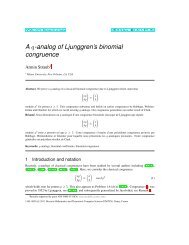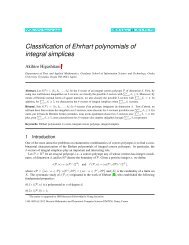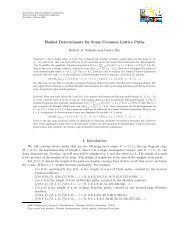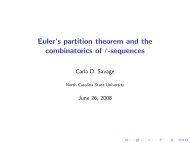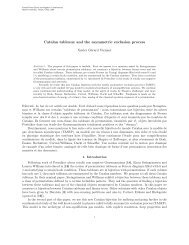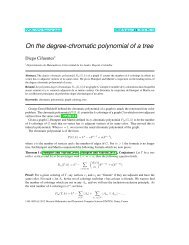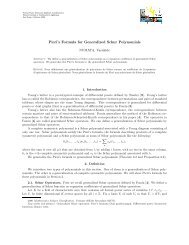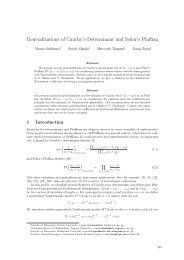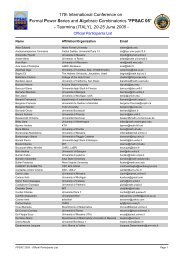enumeration of self-complementary plane partitions
enumeration of self-complementary plane partitions
enumeration of self-complementary plane partitions
Create successful ePaper yourself
Turn your PDF publications into a flip-book with our unique Google optimized e-Paper software.
(−1)–ENUMERATION OF SELF–COMPLEMENTARY PLANE<br />
PARTITIONS<br />
THERESIA EISENKÖLBL<br />
Fakultät für Mathematik, Universität Wien,<br />
Nordbergstraße 15, A-1090 Wien, Austria.<br />
E-mail: Theresia.Eisenkoelbl@univie.ac.at<br />
Abstract. We prove a product formula for the remaining cases <strong>of</strong> the weighted<br />
<strong>enumeration</strong> <strong>of</strong> <strong>self</strong>–<strong>complementary</strong> <strong>plane</strong> <strong>partitions</strong> contained in a given box where<br />
adding one half <strong>of</strong> an orbit <strong>of</strong> cubes and removing the other half <strong>of</strong> the orbit changes the<br />
weight by −1. We use nonintersecting lattice path families to express this <strong>enumeration</strong><br />
as a Pfaffian which can be expressed in terms <strong>of</strong> the known ordinary <strong>enumeration</strong> <strong>of</strong><br />
<strong>self</strong>–<strong>complementary</strong> <strong>plane</strong> <strong>partitions</strong>.<br />
1. Introduction<br />
A <strong>plane</strong> partition P can be defined as a finite set <strong>of</strong> integer points (i, j, k) with<br />
i, j, k > 0 and if (i, j, k) ∈ P and 1 ≤ i ′ ≤ i, 1 ≤ j ′ ≤ j, 1 ≤ k ′ ≤ k then (i ′ , j ′ , k ′ ) ∈ P .<br />
We interpret these points as midpoints <strong>of</strong> cubes and represent a <strong>plane</strong> partition by<br />
stacks <strong>of</strong> cubes (see Figure 1). If we have i ≤ a, j ≤ b and k ≤ c for all cubes <strong>of</strong> the<br />
<strong>plane</strong> partition, we say that the <strong>plane</strong> partition is contained in a box with sidelengths<br />
a, b, c.<br />
Plane <strong>partitions</strong> were first introduced by MacMahon. One <strong>of</strong> his main results is the<br />
following [10, Art. 429, x → 1, pro<strong>of</strong> in Art. 494]:<br />
The number <strong>of</strong> all <strong>plane</strong> <strong>partitions</strong> contained in a box with sidelengths a, b, c equals<br />
B(a, b, c) =<br />
a∏<br />
b∏<br />
c∏<br />
i=1 j=1 k=1<br />
i + j + k − 1<br />
a∏<br />
i + j + k − 2 =<br />
i=1<br />
(c + i) b<br />
(i) b<br />
, (1)<br />
where (a) n := a(a + 1)(a + 2) . . . (a + n − 1) is the rising factorial.<br />
MacMahon also started the investigation <strong>of</strong> the number <strong>of</strong> <strong>plane</strong> <strong>partitions</strong> with<br />
certain symmetries in a given box. These numbers can also be expressed as product<br />
formulas similar to the one given above. In [14], Stanley introduced additional complementation<br />
symmetries giving six new combinations <strong>of</strong> symmetries which led to more<br />
conjectures all <strong>of</strong> which were settled in the 1980’s and 90’s (see [14, 8, 3, 17]).<br />
Many <strong>of</strong> these theorems come with q–analogs, that is, weighted versions that record<br />
the number <strong>of</strong> cubes or orbits <strong>of</strong> cubes by a power <strong>of</strong> q and give expressions containing<br />
q–rising factorials instead <strong>of</strong> rising factorials (see [1, 2, 11]). For <strong>plane</strong> <strong>partitions</strong> with<br />
complementation symmetry, it seems to be difficult to find natural q–analogs. However,<br />
2000 Mathematics Subject Classification. Primary 05A15; Secondary 05B45 52C20.<br />
Key words and phrases. lozenge tilings, rhombus tilings, <strong>plane</strong> <strong>partitions</strong>, determinants, pfaffians,<br />
nonintersecting lattice paths.<br />
111
T. EISENKOEBL<br />
2 THERESIA EISENKÖLBL<br />
Figure 1. A <strong>self</strong>–<strong>complementary</strong> <strong>plane</strong> partition<br />
in Stanley’s paper a q–analog for <strong>self</strong>–<strong>complementary</strong> <strong>plane</strong> <strong>partitions</strong> is given (the<br />
weight is not symmetric in the three sidelengths, but the result is). Interestingly, upon<br />
setting q = −1 in the various q–analogs, one consistently obtains <strong>enumeration</strong>s <strong>of</strong> other<br />
objects, usually with additional symmetry restraints. This observation, dubbed the<br />
“’(−1)–phenomenon” has been explained for many but not all cases by Stembridge (see<br />
[15] and [16]).<br />
In [7], Kuperberg defines a (−1)–<strong>enumeration</strong> for all <strong>plane</strong> <strong>partitions</strong> with complementation<br />
symmetry which admits a nice closed product formula in almost all cases.<br />
These conjectures were solved in Kuperberg’s own paper and in the paper [4] except<br />
for one case without a nice product formula and the case <strong>of</strong> <strong>self</strong>-<strong>complementary</strong> <strong>plane</strong><br />
<strong>partitions</strong> in a box with some odd sidelengths which will be the main theorem <strong>of</strong> this<br />
paper. We start with the precise definitions.<br />
A <strong>plane</strong> partition P contained in the box a × b × c is called <strong>self</strong>–<strong>complementary</strong> if<br />
(i, j, k) ∈ P ⇔ (a + 1 − i, b + 1 − j, c + 1 − k) /∈ P for 1 ≤ i ≤ a, 1 ≤ j ≤ b, 1 ≤ k ≤ c.<br />
This means that the box consists exactly <strong>of</strong> the <strong>plane</strong> partition and the image obtained<br />
from it by symmetry with respect to the central point <strong>of</strong> the box.<br />
A convenient way to look at a <strong>self</strong>–<strong>complementary</strong> <strong>plane</strong> partition is the projection<br />
to the <strong>plane</strong> along the (1, 1, 1)–direction (see Figure 1). A <strong>plane</strong> partition contained in<br />
an a × b × c–box becomes a rhombus tiling <strong>of</strong> a hexagon with sidelengths a, b, c, a, b, c.<br />
It is easy to see that <strong>self</strong>-<strong>complementary</strong> <strong>plane</strong> <strong>partitions</strong> correspond exactly to those<br />
rhombus tilings with a 180 ◦ rotational symmetry.<br />
The (−1)–weight is defined as follows: A <strong>self</strong>–<strong>complementary</strong> <strong>plane</strong> partition contains<br />
exactly one half <strong>of</strong> each orbit under the operation (i, j, k) ↦→ (a+1−i, b+1−j, c+1−k).<br />
Let a move consist <strong>of</strong> removing one half <strong>of</strong> an orbit and adding the other half. Two<br />
<strong>plane</strong> <strong>partitions</strong> are connected either by an odd or by an even number <strong>of</strong> moves, so it<br />
is possible to define a relative sign. The sign becomes absolute if we assign weight 1 to<br />
the half-full <strong>plane</strong> partition (see Figure 2).<br />
112
(-1)-ENUMERATION OF SELF-COMPLEMENTARY PLANE PARTITIONS<br />
(−1)–ENUMERATION OF SELF–COMPLEMENTARY PLANE PARTITIONS 3<br />
Figure 2. A <strong>plane</strong> partition <strong>of</strong> weight 1.<br />
Therefore, this weight is (−1) n(P ) where n(P ) is the number <strong>of</strong> cubes in the “left”<br />
half <strong>of</strong> the box and we want to evaluate ∑ P (−1)n(P ) . For example, the <strong>plane</strong> partition<br />
in Figure 1 has weight (−1) 10 = 1.<br />
In order to be able to state the result for the (−1)–<strong>enumeration</strong> more concisely,<br />
Stanley’s result on the ordinary <strong>enumeration</strong> <strong>of</strong> <strong>self</strong>–<strong>complementary</strong> <strong>plane</strong> <strong>partitions</strong> is<br />
needed. It will also be used as a step in the pro<strong>of</strong> <strong>of</strong> the (−1)–<strong>enumeration</strong>.<br />
Theorem 1 (Stanley [14]). The number SC(a, b, c) <strong>of</strong> <strong>self</strong>–<strong>complementary</strong> <strong>plane</strong> <strong>partitions</strong><br />
contained in a box with sidelengths a, b, c can be expressed in terms <strong>of</strong> B(a, b, c)<br />
in the following way:<br />
B ( a<br />
, b+1,<br />
c−1<br />
2 2 2<br />
B ( a+1<br />
2 , b 2 , c 2<br />
where B(a, b, c) = ∏ a (c+i) b<br />
i=1 (i) b<br />
B ( a<br />
, b , c 2<br />
2 2 2)<br />
for a, b, c even,<br />
) (<br />
B<br />
a , b−1,<br />
)<br />
c+1 for a even and b, c odd,<br />
2 2 2<br />
) (<br />
B<br />
a−1<br />
, b , )<br />
c for a odd and b, c even,<br />
2 2 2<br />
is the number <strong>of</strong> all <strong>plane</strong> <strong>partitions</strong> in an a × b × c–box.<br />
Note that a <strong>self</strong>-<strong>complementary</strong> <strong>plane</strong> partition contains exactly half <strong>of</strong> all cubes in<br />
the box. Therefore, there are no <strong>self</strong>-<strong>complementary</strong> <strong>plane</strong> <strong>partitions</strong> in a box with<br />
three odd sidelengths.<br />
Now we can express the (−1)–<strong>enumeration</strong> <strong>of</strong> <strong>self</strong>–<strong>complementary</strong> <strong>plane</strong> <strong>partitions</strong> in<br />
terms <strong>of</strong> SC(a, b, c), the ordinary <strong>enumeration</strong> <strong>of</strong> <strong>self</strong>–<strong>complementary</strong> <strong>plane</strong> <strong>partitions</strong>.<br />
113
4 THERESIA EISENKÖLBL<br />
Theorem 2. The <strong>enumeration</strong> <strong>of</strong> <strong>self</strong>–<strong>complementary</strong> <strong>plane</strong> <strong>partitions</strong> in a box with<br />
sidelengths a, b, c counted with weight (−1) n(P ) equals<br />
( a<br />
B<br />
2 , b 2 2)<br />
, c )<br />
SC ( a<br />
, b+1,<br />
) ( c−1<br />
2 2 2 SC a , b−1<br />
2<br />
SC ( a+1<br />
2 , b 2 , c 2<br />
, c+1<br />
2 2<br />
)<br />
SC<br />
( a−1<br />
2 , b 2 , c 2<br />
T. EISENKOEBL<br />
)<br />
for a, b, c even,<br />
for a even and b, c odd<br />
for a odd and b, c even<br />
where SC(a, b, c) is given in Theorem 1 in terms <strong>of</strong> the numbers <strong>of</strong> <strong>plane</strong> <strong>partitions</strong><br />
contained in a box and n(P ) is the number <strong>of</strong> cubes in the <strong>plane</strong> partition P that are<br />
not in the half-full <strong>plane</strong> partition (see Figure 2).<br />
Remark. Since the sides <strong>of</strong> the box play symmetric roles this covers all cases. (For<br />
three odd sidelengths there are no <strong>self</strong>-<strong>complementary</strong> <strong>plane</strong> <strong>partitions</strong>.) The case <strong>of</strong><br />
three even sidelengths has already been proved in [4].<br />
Note that Theorem 1 and Theorem 2 are very analogous. In the even case, the (−1)–<br />
<strong>enumeration</strong> is the square root <strong>of</strong> the ordinary <strong>enumeration</strong>. In the other cases, it is<br />
still true that there are half as many linear factors in the (−1)–<strong>enumeration</strong> (viewed as<br />
a polynomial in c, say).<br />
In Stanley’s paper [14], the theorem actually gives a q–<strong>enumeration</strong> <strong>of</strong> <strong>plane</strong> <strong>partitions</strong>.<br />
The case q = −1 gives the same expression as Theorem 2 above if at least one<br />
side has odd length, but this does not give a pro<strong>of</strong> <strong>of</strong> Theorem 2 because the weights <strong>of</strong><br />
individual <strong>plane</strong> <strong>partitions</strong> are different. In the case <strong>of</strong> only even sidelengths, Stanley’s<br />
theorem gives SC (a/2, b/2, c/2) 2 (analogously to Theorem 1) which does not equal the<br />
result B (a/2, b/2, c/2) in Theorem 2.<br />
Stanley’s pro<strong>of</strong> uses a special case <strong>of</strong> the Littlewood-Richardson rule, the expansion<br />
<strong>of</strong> the product <strong>of</strong> Schur functions s λ (x 1 , . . . , x n ) · s µ (x 1 , . . . , x n ) where λ and µ are<br />
rectangular <strong>partitions</strong> whose sidelengths differ by at most one. It is possible to give an<br />
alternative pro<strong>of</strong> <strong>of</strong> Theorem 2 using a modification <strong>of</strong> Stanley’s weight leading to the<br />
expansion <strong>of</strong> s λ (x 1 , . . . , x n+1 ) · s µ (x 1 , . . . , x n ) where λ and µ are rectangular <strong>partitions</strong>.<br />
(Note the different numbers <strong>of</strong> variables.) See also the remark at the end <strong>of</strong> the paper.<br />
2. Outline <strong>of</strong> the pro<strong>of</strong><br />
For brevity, we just give the pro<strong>of</strong> in the case a even, b, c odd and (c − b)/2 even.<br />
Step 1: From <strong>plane</strong> <strong>partitions</strong> to families <strong>of</strong> nonintersecting lattice paths.<br />
We use the projection to the <strong>plane</strong> along the (1, 1, 1)–direction and get immediately<br />
that <strong>self</strong>–<strong>complementary</strong> <strong>plane</strong> <strong>partitions</strong> contained in an a × b × c–box are equivalent<br />
to rhombus tilings <strong>of</strong> a hexagon with sides a, b, c, a, b, c invariant under 180 ◦ –rotation.<br />
A tiling <strong>of</strong> this kind is clearly determined by one half <strong>of</strong> the hexagon.<br />
Since the sidelengths a, b, c play a completely symmetric role and two <strong>of</strong> them must<br />
have the same parity we assume without loss <strong>of</strong> generality that c − b is even and b ≤ c.<br />
The result turns out to be symmetric in b and c, so we can drop the last condition<br />
in the statement <strong>of</strong> Theorem 2. Write x for the positive integer (c − b)/2 and divide<br />
the hexagon in half with a line parallel to the side <strong>of</strong> length a (see Figure 3). As<br />
shown in the same figure, we find a bijection between these tiled halves and families <strong>of</strong><br />
nonintersecting lattice paths.<br />
114
(-1)-ENUMERATION OF SELF-COMPLEMENTARY PLANE PARTITIONS<br />
(−1)–ENUMERATION OF SELF–COMPLEMENTARY PLANE PARTITIONS 5<br />
⎧<br />
⎪⎨<br />
b<br />
⎪⎩<br />
{<br />
x<br />
⎪⎩<br />
a<br />
⎪⎭<br />
⎪⎨<br />
⎧⎫⎪ ⎬<br />
⎪ ⎭<br />
⎪⎬<br />
a + b<br />
c − x<br />
⎫<br />
• • • ◦• • • •<br />
• • ◦• • • • ◦•<br />
• ◦• • • • ◦• •<br />
◦• • • • • • •<br />
• • • ◦• • • •<br />
• • ◦• • • • •<br />
A 1<br />
A 2<br />
A 3<br />
A 4<br />
E 2<br />
E 3<br />
E 5<br />
E 6<br />
• • • • • • •<br />
Figure 3. The paths for the <strong>self</strong>–<strong>complementary</strong> <strong>plane</strong> partition in Figure<br />
1 and the orthogonal version. (x = c−b<br />
2 )<br />
The starting points <strong>of</strong> the lattice paths are the midpoints <strong>of</strong> the edges on the side <strong>of</strong><br />
length a. The end points are the midpoints <strong>of</strong> the edges parallel to a on the opposite<br />
boundary. This is a symmetric subset <strong>of</strong> the midpoints on the cutting line <strong>of</strong> length<br />
a + b.<br />
The paths always follow the rhombi <strong>of</strong> the given tiling by connecting midpoints <strong>of</strong><br />
parallel rhombus edges. It is easily seen that the resulting paths have no common points<br />
(i.e. they are nonintersecting) and the tiling can be recovered from a nonintersecting<br />
lattice path family with unit diagonal and down steps and appropriate starting and<br />
end points. Of course, the path families will have to be counted with the appropriate<br />
(−1)–weight.<br />
After changing to an orthogonal coordinate system (see Figure 3), the paths are<br />
composed <strong>of</strong> unit South and East steps and the coordinates <strong>of</strong> the starting points are<br />
A i = (i − 1, b + i − 1) for i = 1, . . . , a. (2)<br />
The end points are a points chosen symmetrically among<br />
E j = (x + j − 1, j − 1) for j = 1, . . . , a + b. (3)<br />
Here, symmetrically means that if E j is chosen, then E a+b+1−j must be chosen as well.<br />
Note that the number a + b <strong>of</strong> potential end points on the cutting line is always odd.<br />
Therefore, there is a middle one which is in no path family for even a (see Figure 3).<br />
Now the (−1)–weight has to be defined for the paths. For a path from A i to E j we<br />
can use the weight (−1) area(P ) where area(P ) is the area between the path and the x–<br />
axis and then multiply the weights <strong>of</strong> all the paths in the family. We have to check that<br />
the weight changes sign if we replace a half orbit with the <strong>complementary</strong> half orbit. If<br />
one <strong>of</strong> the affected cubes is completely inside the half shown in Figure 3, ∑ P area(P )<br />
changes by one. If the two affected cubes are on the border <strong>of</strong> the figure, two symmetric<br />
endpoints, say E j and E a+b+1−j , are changed to E j+1 and E a+b−j or vice versa. It is<br />
easily checked that in this case ∑ P<br />
area(P ) changes by j + (a + b − j) which is odd.<br />
115
6 THERESIA EISENKÖLBL<br />
It is straightforward to check that the weight for the “half-full” <strong>plane</strong> partition (see<br />
Figure 2) equals (−1) a(a−2)/8 for a even, b, c odd. Therefore, we have to multiply the<br />
path <strong>enumeration</strong> by this global sign.<br />
Step 2: From lattice paths to a sum <strong>of</strong> determinants<br />
This weight can be expressed as a product <strong>of</strong> weights on individual steps (the exponent<br />
<strong>of</strong> (−1) is just the height <strong>of</strong> the step), so the following lemma is applicable. By<br />
the main theorem on nonintersecting lattice paths (see [9, Lemma 1] or [5, Theorem 1])<br />
the weighted count <strong>of</strong> such families <strong>of</strong> paths can be expressed as a determinant.<br />
Lemma 3. Let A 1 , A 2 , . . . , A n , E 1 , E 2 , . . . , E n be integer points meeting the following<br />
condition: Any path from A i to E l has a common vertex with any path from A j to E k<br />
for any i, j, k, l with i < j and k < l.<br />
Then we have<br />
P(A → E, nonint.) =<br />
det (P(A i → E j )), (4)<br />
1≤i,j≤n<br />
where P(A i → E j ) denotes the weighted <strong>enumeration</strong> <strong>of</strong> all paths running from A i to<br />
E j and P(A → E, nonint.) denotes the weighted <strong>enumeration</strong> <strong>of</strong> all families <strong>of</strong> nonintersecting<br />
lattice paths running from A i to E i for i = 1, . . . , n.<br />
The condition on the starting and end points is fulfilled in our case because the points<br />
lie on diagonals, so we have to find an expression for T ij = P(A i → E j ), the weighted<br />
<strong>enumeration</strong> <strong>of</strong> all single paths from A i to E j in our problem.<br />
It is well-known that the <strong>enumeration</strong> <strong>of</strong> paths <strong>of</strong> this kind from (x, y) to (x ′ , y ′ ) is<br />
given by the q–binomial coefficient [ ]<br />
x ′ −x+y−y ′<br />
if the weight <strong>of</strong> a path is x ′ −x q qe where e is<br />
the area between the path and a horizontal line through its endpoint.<br />
The q–binomial coefficient (see [13, p. 26] for further information) can be defined as<br />
[ ∏ n<br />
n j=n−k+1<br />
=<br />
k]<br />
(1 − qj )<br />
∏ k<br />
j=1 (1 − .<br />
qj )<br />
q<br />
T. EISENKOEBL<br />
Although it is not obvious from this definition, the q–binomial coefficient is a polynomial<br />
in q. So it makes sense to put q = −1.<br />
It is easy to verify that<br />
[ {<br />
n 0 n even, k odd,<br />
= (<br />
k]<br />
⌊n/2⌋<br />
)<br />
(5)<br />
−1<br />
else.<br />
⌊k/2⌋<br />
Taking also into account the area between the horizontal line through the endpoint<br />
and the x–axis, we obtain<br />
[ ] b + x<br />
T ij = P(A i → E j ) = (−1) (x+j−i)(j−1) .<br />
b + i − j<br />
−1<br />
Now we apply Lemma 3 to all possible sets <strong>of</strong> end points. Thus, the (−1)–<strong>enumeration</strong><br />
can be expressed as a sum <strong>of</strong> determinants which are minors <strong>of</strong> the a × (a + b)–matrix<br />
T :<br />
Lemma 4. The (−1)–<strong>enumeration</strong> can be written as<br />
116
(-1)-ENUMERATION OF SELF-COMPLEMENTARY PLANE PARTITIONS<br />
(−1)–ENUMERATION OF SELF–COMPLEMENTARY PLANE PARTITIONS 7<br />
(−1) a(a−2)/8<br />
∑<br />
1≤k 1
8 THERESIA EISENKÖLBL<br />
where T ij = (−1) (x−i)(j−1)[ ]<br />
b+x<br />
b+i−j<br />
−1<br />
(and x = (c − b)/2).<br />
Pro<strong>of</strong>. Apply the lemma with 2m = a, 2n = a + b − 1 and<br />
S = (T 1 , . . . , T a+b−1<br />
2<br />
T. EISENKOEBL<br />
, T a+b+3 , . . . , T a+b )<br />
2<br />
to obtain<br />
⎛<br />
a+b−1<br />
2∑<br />
Pf 1≤i,j≤a<br />
⎝<br />
k=1<br />
⎞<br />
(T ik T j,a+b+1−k − T jk T i,a+b+1−k ) ⎠ .<br />
□<br />
Lemma 7. The Pfaffian for the ordinary <strong>enumeration</strong> SC(a, b, c) for b ≤ c is<br />
⎛<br />
⌊<br />
⎜<br />
∑<br />
a+b<br />
Pf 1≤i,j≤a ⎝<br />
2 ⌋<br />
k=1<br />
(( b + x<br />
)(<br />
b + x<br />
)<br />
b + i − k j + k − a − 1<br />
−<br />
( )(<br />
)) ⎞ b + x b + x ⎟ ⎠<br />
b + j − k i + k − a − 1<br />
for a and c − b even.<br />
Pro<strong>of</strong>. Replace T ij by the ordinary <strong>enumeration</strong> <strong>of</strong> the respective paths. This replaces<br />
(−1)–binomial coefficients by ordinary ones. (Doing the same thing for the analogous<br />
expressions in Section 9 <strong>of</strong> [4] gives the result for the case <strong>of</strong> even sidelengths.) □<br />
Remark. Of course, the closed form <strong>of</strong> this Pfaffian is known by Stanley’s theorem<br />
(see Theorem 1). Therefore, we can use them to evaluate the Pfaffian for the (−1)–<br />
<strong>enumeration</strong>.<br />
Step 4: Evaluation <strong>of</strong> the Pfaffian<br />
Now, the Pfaffian <strong>of</strong> Lemma 6 can be reduced to products <strong>of</strong> the known Pfaffians<br />
in Lemma 7 corresponding to the ordinary <strong>enumeration</strong>. The calculations have to be<br />
done separately for different parities <strong>of</strong> the parameters and we present only the case<br />
a, x even, b, c odd.<br />
For M ij in Pf M we can write<br />
∑<br />
(a+b−1)/2<br />
k=1<br />
(( )( )<br />
(b + x − 1)/2 (b + x − 1)/2<br />
(−1) (k+1)(i+j) ⌊(b + i − k)/2⌋ ⌊(j + k − a − 1)/2⌋<br />
( )( ))<br />
(b + x − 1)/2 (b + x − 1)/2<br />
−<br />
⌊(b + j − k)/2⌋ ⌊(i + k − a − 1)/2⌋<br />
with 1 ≤ i, j ≤ a.<br />
Splitting the sum into terms k = 2l and k = 2l − 1 gives<br />
118
(-1)-ENUMERATION OF SELF-COMPLEMENTARY PLANE PARTITIONS<br />
(−1)–ENUMERATION OF SELF–COMPLEMENTARY PLANE PARTITIONS 9<br />
∑<br />
⌊(a+b−1)/4⌋<br />
l=1<br />
((<br />
)(<br />
)<br />
(−1) i+j (b + x − 1)/2<br />
(b + x − 1)/2<br />
(b − 1)/2 + ⌊(i − 1)/2⌋ − l + 1 ⌊(j − 1)/2⌋ + l − a/2<br />
(<br />
)(<br />
))<br />
(b + x − 1)/2<br />
(b + x − 1)/2<br />
−<br />
(b − 1)/2 + ⌊(j − 1)/2⌋ − l + 1 ⌊(i − 1)/2⌋ + l − a/2<br />
⌈(a+b−1)/4⌉<br />
∑<br />
((<br />
)( )<br />
(b + x − 1)/2<br />
(b + x − 1)/2<br />
+<br />
(b − 1)/2 + ⌊i/2⌋ − l + 1 ⌊j/2⌋ + l − a/2 − 1<br />
l=1<br />
(<br />
)( ))<br />
(b + x − 1)/2<br />
(b + x − 1)/2<br />
−<br />
(b − 1)/2 + ⌊j/2⌋ − l + 1 ⌊i/2⌋ + l − a/2 − 1<br />
Now we apply some row and column operations to our matrix M. Start with row(1),<br />
then write the differences row(2i + 1) − row(2i) for i = 1, . . . , a/2 − 1, and finally<br />
row(2i−1)+row(2i) for i = 1, . . . , a/2. Now apply the same operations to the columns,<br />
so that the resulting matrix is still skew–symmetric. The new matrix has the same<br />
Pfaffian only up to sign (−1) (a/2)(a/2−1)/2 which cancels with the global sign in Lemma 6.<br />
Computation gives:<br />
⌊(a+b−1)/4⌋<br />
∑<br />
(( )(<br />
)<br />
(b + x − 1)/2 + 1<br />
M 2i+1,j −M 2i,j = − (−1) j (b + x − 1)/2<br />
(b − 1)/2 + i − l + 1 ⌊(j − 1)/2⌋ + l − a/2<br />
l=1<br />
(<br />
)( ))<br />
(b + x − 1)/2<br />
(b + x − 1)/2 + 1<br />
−<br />
(b − 1)/2 + ⌊(j − 1)/2⌋ − l + 1 i + l − a/2<br />
Thus, apart from the first row and column, the left upper corner looks like<br />
M 2i+1,2j+1 − M 2i,2j+1 − M 2i+1,2j + M 2i,2j<br />
⌊(a+b−1)/4⌋<br />
∑<br />
(( )( )<br />
(b + x − 1)/2 + 1 (b + x − 1)/2 + 1<br />
=<br />
(b − 1)/2 + i − l + 1 j + l − a/2<br />
l=1<br />
( )( ))<br />
(b + x − 1)/2 + 1 (b + x − 1)/2 + 1<br />
−<br />
, (7)<br />
(b − 1)/2 + j − l + 1 i + l − a/2<br />
where i, j = 1, . . . a/2 − 1. Note how similar this is to the original matrix, only the<br />
(−1)–binomial coefficients are now replaced with ordinary binomial coefficients. The<br />
goal is to identify two blocks in the matrix which correspond to ordinary <strong>enumeration</strong><br />
<strong>of</strong> <strong>self</strong>–<strong>complementary</strong> <strong>plane</strong> <strong>partitions</strong>.<br />
The right upper corner is zero (<strong>of</strong> size (a/2 − 1) × a/2).<br />
Furthermore,<br />
M 2i−1,j + M 2i,j =<br />
⌈(a+b−1)/4⌉<br />
∑<br />
l=1<br />
(( )( )<br />
(b + x − 1)/2 + 1 (b + x − 1)/2<br />
(b − 1)/2 + i − l + 1 ⌊j/2⌋ + l − a/2 − 1<br />
(<br />
)( ))<br />
(b + x − 1)/2 (b + x − 1)/2 + 1<br />
−<br />
(b − 1)/2 + ⌊j/2⌋ − l + 1 i + l − a/2 − 1<br />
Therefore, we get for the right lower corner <strong>of</strong> the matrix<br />
(6)<br />
119
T. EISENKOEBL<br />
10 THERESIA EISENKÖLBL<br />
M 2i−1,2j−1 + M 2i,2j−1 + M 2i−1,2j + M 2i,2j<br />
⌈(a+b−1)/4⌉<br />
∑<br />
(( )( )<br />
(b + x − 1)/2 + 1 (b + x − 1)/2 + 1<br />
=<br />
(b − 1)/2 + i − l + 1 j + l − a/2 − 1<br />
l=1<br />
( )( ))<br />
(b + x − 1)/2 + 1 (b + x − 1)/2 + 1<br />
−<br />
, (8)<br />
(b − 1)/2 + j − l + 1 i + l − a/2 − 1<br />
where i, j = 1, . . . , a/2.<br />
This is almost a block diagonal matrix, only the first row and column spoil the<br />
picture.<br />
Example (a = 8, b = 3, c = 7):<br />
⎛<br />
⎜<br />
⎝<br />
0 0 1 5 0 0 −1 −5<br />
0 0 3 12 0 0 0 0<br />
−1 −3 0 9 0 0 0 0<br />
−5 −12 −9 0 0 0 0 0<br />
0 0 0 0 0 −1 −6 −15<br />
0 0 0 0 1 0 −9 −18<br />
1 0 0 0 6 9 0 −9<br />
5 0 0 0 15 18 9 0<br />
If (a/2) is even, the right lower corner is an (a/2) × (a/2)–matrix with non-zero<br />
determinant, as we will see later, thus, we can use the last a/2 rows to annihilate the<br />
second half <strong>of</strong> the first row. This potentially changes the entry 0 in position (1, 1), but<br />
leaves everything else unchanged. We can use the same linear combination on the last<br />
a/2 columns to annihilate the second half <strong>of</strong> the first column. The resulting matrix<br />
is again skew–symmetric which means that the entry (1, 1) has returned to the value<br />
0. Since simultaneous row and column manipulations <strong>of</strong> this kind leave the Pfaffian<br />
unchanged, it remains to find out the Pfaffian <strong>of</strong> the right lower corner (a/2 × a/2) and<br />
the Pfaffian <strong>of</strong> the left upper corner (a/2 × a/2).<br />
The right lower block is given by Equation (8). This corresponds exactly to the<br />
ordinary <strong>enumeration</strong> <strong>of</strong> <strong>self</strong>–<strong>complementary</strong> <strong>plane</strong> <strong>partitions</strong> in Lemma 7. Therefore,<br />
the Pfaffian <strong>of</strong> this block is SC(a/2, (b + 1)/2, (c + 1)/2) (which is non-zero as claimed).<br />
The left upper a/2 × a/2 block (including the first row and column) is<br />
⎛<br />
⎜<br />
⎝<br />
0 M 1,2j+1 − M 1,2j<br />
M 2i+1,1 − M 2i,1<br />
⌊ a+b−1<br />
4 ⌋<br />
∑<br />
l=1<br />
( ( (b+x+1)/2<br />
(b−1)/2+i−l+1<br />
where i, j run from 0 to a/2 − 1 and<br />
)( (b+x+1)/2<br />
j+l−a/2<br />
⎞<br />
⎟<br />
⎠<br />
)<br />
−<br />
( (b+x+1)/2<br />
(b−1)/2+j−l+1<br />
)( (b+x+1)/2<br />
i+l−a/2<br />
⎞<br />
) ) ⎟<br />
⎠ ,<br />
120
(-1)-ENUMERATION OF SELF-COMPLEMENTARY PLANE PARTITIONS<br />
(−1)–ENUMERATION OF SELF–COMPLEMENTARY PLANE PARTITIONS 11<br />
M 2i+1,1 − M 2i,1 =<br />
M 1,2j+1 − M 1,2j =<br />
⌊(a+b−1)/4⌋<br />
∑<br />
l=1<br />
⌊(a+b−1)/4⌋<br />
∑<br />
l=1<br />
( ( (b+x+1)/2<br />
(b−1)/2+i−l+1<br />
( ( (b+x−1)/2<br />
(b−1)/2−l+1<br />
)( (b+x−1)/2<br />
l−a/2<br />
)( (b+x+1)/2<br />
j+l−a/2<br />
)<br />
−<br />
( (b+x−1)/2<br />
(b−1)/2−l+1<br />
)<br />
−<br />
( (b+x+1)/2<br />
(b−1)/2+j−l+1<br />
)( (b+x+1)/2<br />
i+l−a/2<br />
)( (b+x−1)/2<br />
l−a/2<br />
Note that the exceptional row and column almost fit the general pattern. We just have<br />
sometimes (b+x−1)/2 instead <strong>of</strong> (b+x+1)/2. Replace row(i) with row(i)−row(i−1)<br />
for i = 1, 2, . . . , a/2 − 1 in that order. Then do the same thing for the columns. In the<br />
resulting matrix all occurrences <strong>of</strong> (b + x + 1)/2 have been replaced with (b + x − 1)/2.<br />
After shifting the indices by one, we get<br />
⌊ a+b−1<br />
4 ⌋<br />
∑<br />
l=1<br />
( ( (b+x−1)/2<br />
(b−1)/2+i−l<br />
)( (b+x−1)/2<br />
j+l−a/2−1<br />
)<br />
−<br />
( (b+x−1)/2<br />
(b−1)/2+j−l<br />
)( (b+x−1)/2<br />
i+l−a/2−1) ) ,<br />
for i, j = 1, . . . , a/2.<br />
The Pfaffian <strong>of</strong> this matrix can easily be identified as SC( a, b−1<br />
2<br />
Using Theorem 1, we obtain for the (−1)–<strong>enumeration</strong><br />
SC( a , b+1 , c+1 )SC( a , b−1 , c−1 ) = SC ( a<br />
, b+1 , c−1<br />
2 2 2 2 2 2 2 2 2<br />
, c−1<br />
2 2<br />
) (<br />
SC<br />
a , b−1 , ) c+1<br />
2 2 2 ,<br />
) )<br />
) ) .<br />
) by Lemma 7.<br />
which proves the main theorem in this case.<br />
If (a/2) is odd, we move the first row and column to the (a/2)th place (which does<br />
not change the sign). Now we have an (a−2)/2×(a−2)/2–block matrix in the left upper<br />
corner which has non-zero determinant and thus can be used to annihilate the first half<br />
<strong>of</strong> the exceptional row and column similar to the previous case. By Equation (7) and<br />
Lemma 7 this is clearly SC((a − 2)/2, (b + 1)/2, (c + 1)/2).<br />
For the right lower (a + 2)/2 × (a + 2)/2–block, note that the relevant half <strong>of</strong> the<br />
exceptional column is<br />
M 2i−1,1 + M 2i,1 =<br />
⌈(a+b−1)/4⌉<br />
∑<br />
l=1<br />
(( (b + x + 1)/2<br />
)( )<br />
(b + x − 1)/2<br />
(b + 1)/2 + i − l l − a/2 − 1<br />
( (b + x − 1)/2<br />
−<br />
(b + 1)/2 − l<br />
)( (b + x + 1)/2<br />
i + l − a/2 − 1<br />
))<br />
.<br />
We use again row and column operations <strong>of</strong> the type row(i)−row(i−1). This changes<br />
all occurrences <strong>of</strong> (b + x + 1)/2 to (b + x − 1)/2 and the extra row and column now fit<br />
the pattern in Equation (8) with i, j = 0. After shifting i, j to i − 1, j − 1, we identify<br />
this Pfaffian as SC((a + 2)/2, (b − 1)/2, (c − 1)/2). Again, by Theorem 1, the product<br />
<strong>of</strong> the two terms is exactly SC(a/2, (b − 1)/2, (c + 1)/2)SC(a/2, (b + 1)/2, (c − 1)/2) as<br />
claimed in the theorem.<br />
□<br />
Remark. In the Pfaffian expression for the various <strong>enumeration</strong>s, it is possible to<br />
replace the occurrences <strong>of</strong> x with different variables and still get a nice factorisation.<br />
For example, the Pfaffian in Lemma 7 is changed to<br />
121
T. EISENKOEBL<br />
12 THERESIA EISENKÖLBL<br />
⎛<br />
⌊<br />
⎜ ∑<br />
a+b<br />
Pf 1≤i,j≤a ⎝<br />
2 ⌋<br />
k=1<br />
(( b + y1<br />
)(<br />
b + y 2<br />
)<br />
b + i − k j + k − a − 1<br />
−<br />
( )(<br />
)) ⎞ b + y1 b + y 2 ⎟ ⎠ .<br />
b + j − k i + k − a − 1<br />
The Pfaffian <strong>of</strong> this matrix is still a product <strong>of</strong> linear factors each involving only one<br />
<strong>of</strong> the two variables y 1 and y 2 . Each <strong>of</strong> these groups <strong>of</strong> factors corresponds to one <strong>of</strong><br />
the B(·, ·, ·)–factors in Theorem 1.<br />
This new matrix corresponds to <strong>self</strong>-<strong>complementary</strong> <strong>plane</strong> <strong>partitions</strong> with certain restrictions<br />
which leads to a modification <strong>of</strong> Stanley’s pro<strong>of</strong> giving an alternative pro<strong>of</strong> <strong>of</strong><br />
Theorem 2 using the expansion <strong>of</strong> s λ (x 1 , . . . , x n+1 ) · s µ (x 1 , . . . , x n ) where λ and µ are<br />
rectangular <strong>partitions</strong>. (Note the different numbers <strong>of</strong> variables.)<br />
References<br />
[1] G. E. Andrews, Plane <strong>partitions</strong> (II): The equivalence <strong>of</strong> the Bender–Knuth and the MacMahon<br />
conjectures, Pacific J. Math., 72 (1977), 283–291.<br />
[2] G. E. Andrews, Plane <strong>partitions</strong> (I): The MacMahon conjecture, Adv. in Math. Suppl. Studies, 1<br />
(1978), 131–150.<br />
[3] G. E. Andrews, Plane <strong>partitions</strong> V: The t.s.s.c.p.p. conjecture, J. Combin. Theory Ser. A, 66<br />
(1994), 28–39.<br />
[4] T. Eisenkölbl, (−1)-<strong>enumeration</strong> <strong>of</strong> <strong>plane</strong> <strong>partitions</strong> with complementation symmetry, Adv. in<br />
Appl. Math. 30, (2003), no. 1-2, 53–95, arXiv:math.CO/0011175.<br />
[5] I.M. Gessel, X. Viennot, Determinant, paths and <strong>plane</strong> <strong>partitions</strong>, Preprint, (1989).<br />
[6] M. Ishikawa and M. Wakayama, Minor summation formula <strong>of</strong> Pfaffians, Linear and Multilinear<br />
Algebra 39 (1995), 285–305.<br />
[7] G. Kuperberg, An exploration <strong>of</strong> the permanent-determinant method, Electron. J. Combin. 5,<br />
(1998), #R46, arXiv:math.CO/9810091.<br />
[8] G. Kuperberg, Symmetries <strong>of</strong> <strong>plane</strong> <strong>partitions</strong> and the permanent determinant method, J. Combin.<br />
Theory Ser. A 68 (1994), 115–151.<br />
[9] B. Lindström, On the vector representations <strong>of</strong> induced matroids, Bull. London Math. Soc. 5<br />
(1973), 85–90.<br />
[10] P.A. MacMahon, Combinatory Analysis, vol. 2, Cambridge University Press, (1916); reprinted by<br />
Chelsea, New York, (1960).<br />
[11] W. H. Mills, D. H. Robbins and H. Rumsey, Pro<strong>of</strong> <strong>of</strong> the Macdonald conjecture, Inventiones Math.<br />
66, (1982), 73–87.<br />
[12] S. Okada, Applications <strong>of</strong> minor summation formulas to rectangular-shaped representations <strong>of</strong><br />
classical groups, J. Algebra, 205, (1998), 337–367.<br />
[13] R. P. Stanley, Enumerative Combinatorics, Vol. 1, Wadsworth & Brooks/Cole, Pacific Grove,<br />
California, (1986).<br />
[14] R.P. Stanley, Symmetries <strong>of</strong> <strong>plane</strong> <strong>partitions</strong>, J. Combin. Theory Ser A 43 (1986), 103–113;<br />
Erratum 44 (1987), 310.<br />
[15] J.R. Stembridge, Some hidden relations involving the ten symmetry classes <strong>of</strong> <strong>plane</strong> <strong>partitions</strong>,<br />
J. Combin. Theory Ser. A 68 (1994), 372–409.<br />
[16] J.R. Stembridge, On minuscule representations, <strong>plane</strong> <strong>partitions</strong> and involutions in complex Lie<br />
groups, Duke Math. J. 73 (1994), 469–490.<br />
[17] J. R. Stembridge, The <strong>enumeration</strong> <strong>of</strong> totally symmetric <strong>plane</strong> <strong>partitions</strong>, Adv. in Math. 111<br />
(1995), 227–245.<br />
122



